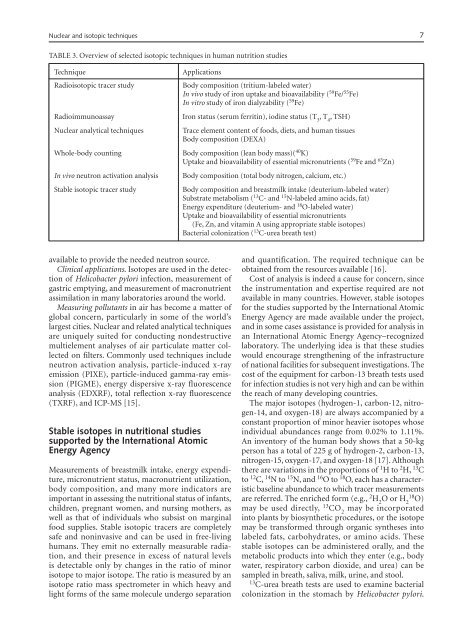F&N Bulletin Vol 23 No 1b - United Nations University
F&N Bulletin Vol 23 No 1b - United Nations University
F&N Bulletin Vol 23 No 1b - United Nations University
You also want an ePaper? Increase the reach of your titles
YUMPU automatically turns print PDFs into web optimized ePapers that Google loves.
Nuclear and isotopic techniques<br />
7<br />
TABLE 3. Overview of selected isotopic techniques in human nutrition studies<br />
Technique<br />
Radioisotopic tracer study<br />
Radioimmunoassay<br />
Nuclear analytical techniques<br />
Applications<br />
Body composition (tritium-labeled water)<br />
In vivo study of iron uptake and bioavailability ( 59 Fe/ 55 Fe)<br />
In vitro study of iron dialyzability ( 59 Fe)<br />
Iron status (serum ferritin), iodine status (T 3<br />
, T 4<br />
, TSH)<br />
Trace element content of foods, diets, and human tissues<br />
Body composition (DEXA)<br />
Whole-body counting Body composition (lean body mass)( 40 K)<br />
Uptake and bioavailability of essential micronutrients ( 59 Fe and 65 Zn)<br />
In vivo neutron activation analysis Body composition (total body nitrogen, calcium, etc.)<br />
Stable isotopic tracer study<br />
Body composition and breastmilk intake (deuterium-labeled water)<br />
Substrate metabolism ( 13 C- and 15 N-labeled amino acids, fat)<br />
Energy expenditure (deuterium- and 18 O-labeled water)<br />
Uptake and bioavailability of essential micronutrients<br />
(Fe, Zn, and vitamin A using appropriate stable isotopes)<br />
Bacterial colonization ( 13 C-urea breath test)<br />
available to provide the needed neutron source.<br />
Clinical applications. Isotopes are used in the detection<br />
of Helicobacter pylori infection, measurement of<br />
gastric emptying, and measurement of macronutrient<br />
assimilation in many laboratories around the world.<br />
Measuring pollutants in air has become a matter of<br />
global concern, particularly in some of the world’s<br />
largest cities. Nuclear and related analytical techniques<br />
are uniquely suited for conducting nondestructive<br />
multielement analyses of air particulate matter collected<br />
on filters. Commonly used techniques include<br />
neutron activation analysis, particle-induced x-ray<br />
emission (PIXE), particle-induced gamma-ray emission<br />
(PIGME), energy dispersive x-ray fluorescence<br />
analysis (EDXRF), total reflection x-ray fluorescence<br />
(TXRF), and ICP-MS [15].<br />
Stable isotopes in nutritional studies<br />
supported by the International Atomic<br />
Energy Agency<br />
Measurements of breastmilk intake, energy expenditure,<br />
micronutrient status, macronutrient utilization,<br />
body composition, and many more indicators are<br />
important in assessing the nutritional status of infants,<br />
children, pregnant women, and nursing mothers, as<br />
well as that of individuals who subsist on marginal<br />
food supplies. Stable isotopic tracers are completely<br />
safe and noninvasive and can be used in free-living<br />
humans. They emit no externally measurable radiation,<br />
and their presence in excess of natural levels<br />
is detectable only by changes in the ratio of minor<br />
isotope to major isotope. The ratio is measured by an<br />
isotope ratio mass spectrometer in which heavy and<br />
light forms of the same molecule undergo separation<br />
and quantification. The required technique can be<br />
obtained from the resources available [16].<br />
Cost of analysis is indeed a cause for concern, since<br />
the instrumentation and expertise required are not<br />
available in many countries. However, stable isotopes<br />
for the studies supported by the International Atomic<br />
Energy Agency are made available under the project,<br />
and in some cases assistance is provided for analysis in<br />
an International Atomic Energy Agency–recognized<br />
laboratory. The underlying idea is that these studies<br />
would encourage strengthening of the infrastructure<br />
of national facilities for subsequent investigations. The<br />
cost of the equipment for carbon-13 breath tests used<br />
for infection studies is not very high and can be within<br />
the reach of many developing countries.<br />
The major isotopes (hydrogen-1, carbon-12, nitrogen-14,<br />
and oxygen-18) are always accompanied by a<br />
constant proportion of minor heavier isotopes whose<br />
individual abundances range from 0.02% to 1.11%.<br />
An inventory of the human body shows that a 50-kg<br />
person has a total of 225 g of hydrogen-2, carbon-13,<br />
nitrogen-15, oxygen-17, and oxygen-18 [17]. Although<br />
there are variations in the proportions of 1 H to 2 H, 13 C<br />
to 12 C, 14 N to 15 N, and 16 O to 18 O, each has a characteristic<br />
baseline abundance to which tracer measurements<br />
are referred. The enriched form (e.g., 2 H 2<br />
O or H 2 18 O)<br />
may be used directly, 13 CO 2<br />
may be incorporated<br />
into plants by biosynthetic procedures, or the isotope<br />
may be transformed through organic syntheses into<br />
labeled fats, carbohydrates, or amino acids. These<br />
stable isotopes can be administered orally, and the<br />
metabolic products into which they enter (e.g., body<br />
water, respiratory carbon dioxide, and urea) can be<br />
sampled in breath, saliva, milk, urine, and stool.<br />
13 C-urea breath tests are used to examine bacterial<br />
colonization in the stomach by Helicobacter pylori.
















